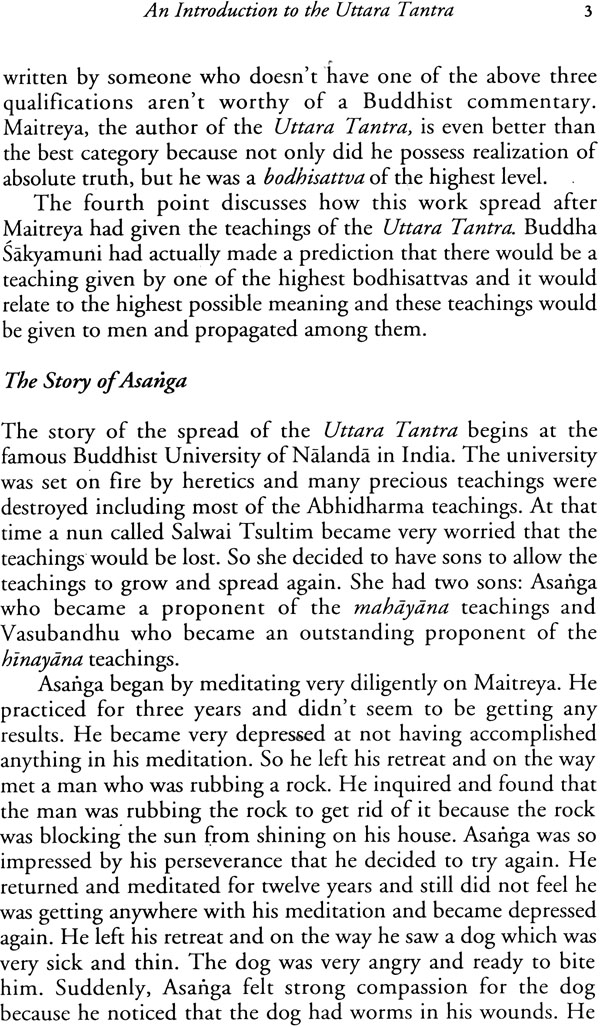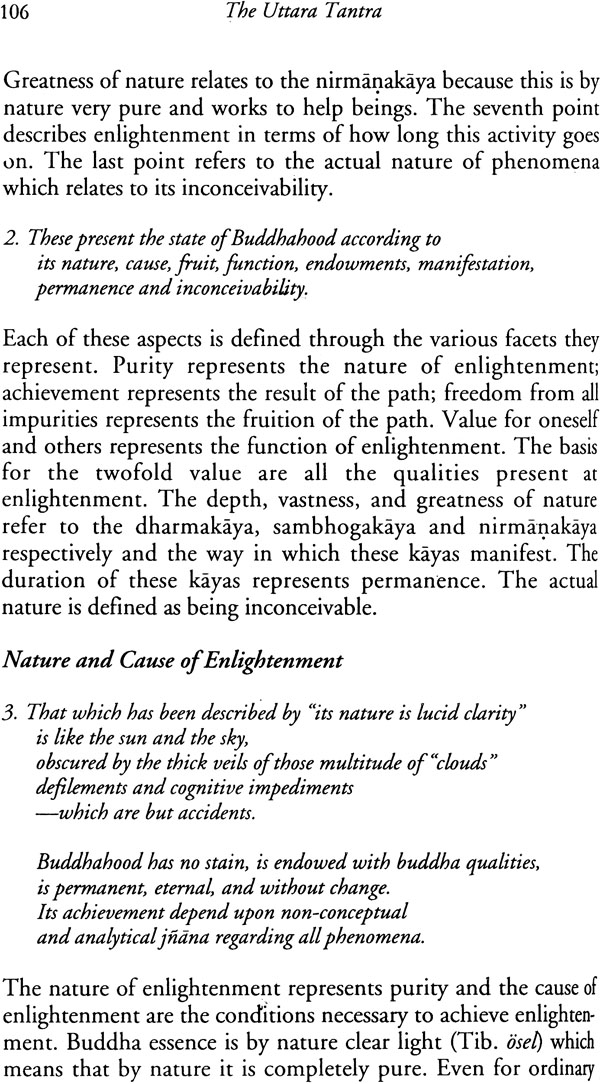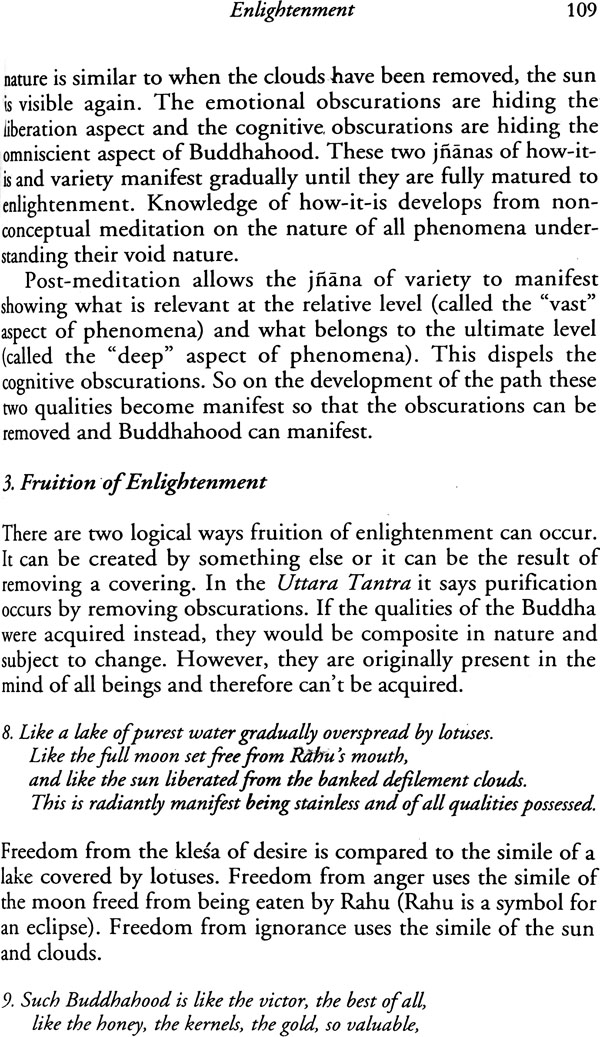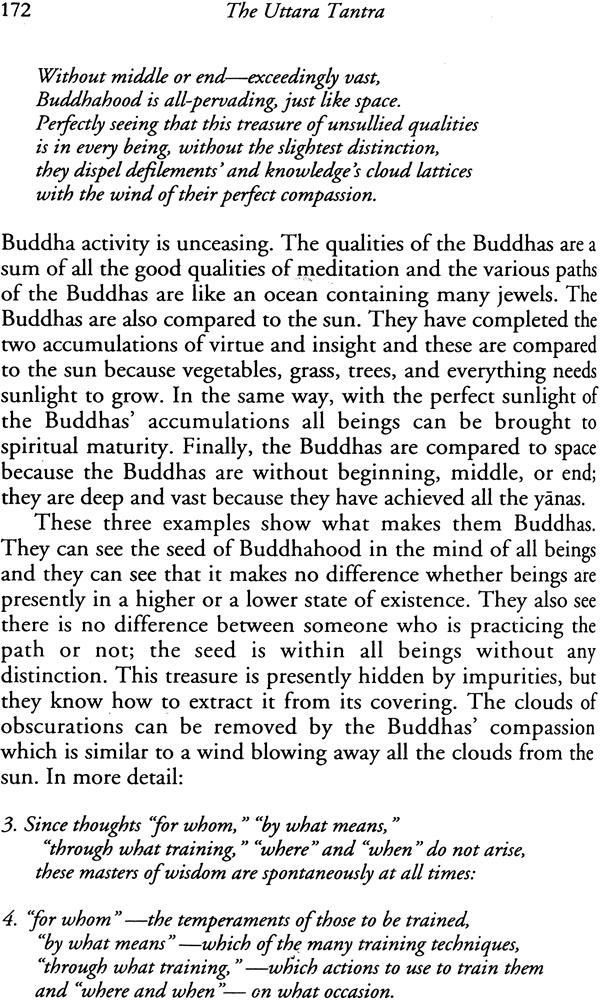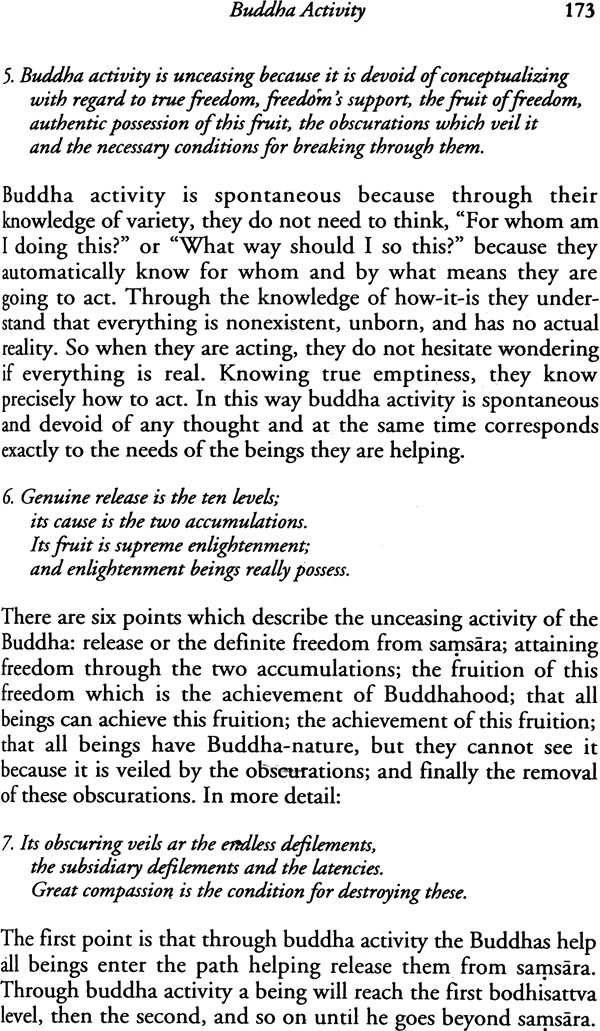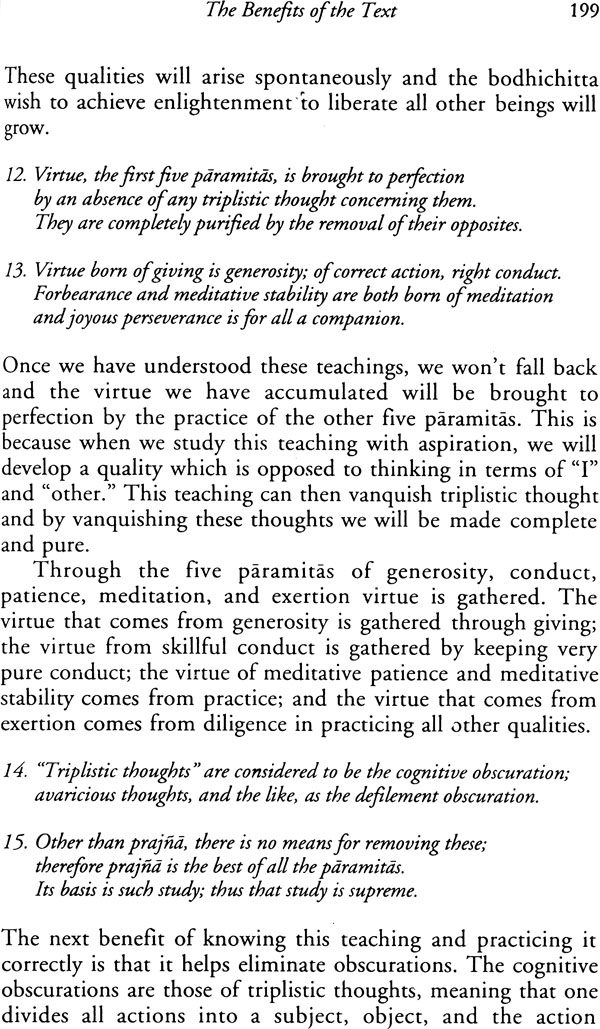
The Uttara Tantra: A Treatise on Buddha Nature
Book Specification
| Item Code: | NAC450 |
| Author: | Thrangu RinpocheGeshe Lharampa |
| Publisher: | Sri Satguru Publications |
| Language: | (A Translation of the Root Text and a Commentary on The Uttara Tantra Sastra of Maitreya and Asanga) |
| Edition: | 2001 |
| ISBN: | 8170306981 |
| Pages: | 220 |
| Cover: | Paperback |
| Other Details | 8.8 Inch X 5.5 Inch |
| Weight | 260 gm |
Book Description
The Uttara Tantra is one of the main texts of the Mahayana path. It establishes that there is Buddha-nature in all sentient beings. It is the presence of this essence which makes it possible for all sentient beings, without a single exception, to eventually achieve enlightenment.
This essence, however, does not simply manifest in ordinary beings because it is covered up by the defilements. The Uttara Tantra goes into detail showing what this essence is and how it is covered up. It also discusses the qualities of a person when all the obscurations are removed so the Uttara Tantra is also a guide to Buddhahood.
Because the understanding of Buddha-nature is essential for the understanding of (he Mahayana path, this text is studies in monastic colleges of all sects in Tibet. however, the root text written by the Maitreya Buddha was written in an extremely terse and subtle language so that the Uttara Tantra is almost always accompanied by a commentary by a lama.
This book provides a translation of the original 406 root verses of he Uttara Tantra as well as a commentary by Thrangu Rinpoche allowing this valuable text to be accessible In Western students. The book also includes and extensive Glossary and Glossary of Tibetan Terms.
Thrangu Rinpoche is well known for taking complex Buddhist subjects and making them understandable and relevant to Western practitioners. He has taught in over 25 countries around the world for the last twenty years.
The Buddhist tradition did not remained frozen at the time of the passing away of the Buddha in the sixth century before our era, but rather remained a living tradition changing depending upon the time and place of the practice. To greatly simplif5r, the first five hundred years of Buddhist teachings were a time of preserving the teachings by memorizing and reciting the words of the Buddha because it was a world where there was little reading and writing. Buddhism flourished primarily in India and emphasized the preservation of the great monastic tradition. The ideal at the time was the arhat who memorized and recited the Sutras, the words of the Buddha, and who practiced perfect discipline and purity and meditated on the Four Noble Truths. This great tradition is still carried on in the southern countries of Asia such as Thailand, Sri Lanka, Burma, Vietnam, and Cambodia. It is also practiced in temples as diverse as the high Himalayan monasteries of Tibet and the Zendos of California.
Around the beginning of our era another great Buddhist tradition arose in India—the mahayana. This tradition emphasized the development of the bodhisattva and began mainly in the Northern monastic universities of India and spread north to Nepal, Tibet, China, Japan, and Korea. A bodhisattva was a person who did not concentrate solely on his r her own enlightenment, but was also very concerned with 2ringing all sentient beings to enlightenment by cultivating compassion and the understanding of emptiness. This was elaborated in a Buddhist literature known as the Prajnaparamita.
So in the first few centuries of our era we had a large collection of Prajnaparamita literature which was, to greatly simply, concerned with the inherent emptiness of self and of phenomena and the two truths of ultimate and conventional reality. Understanding emptiness can be done either by studying the logical arguments great scholars such as Nagarjuna or by the direction examination of mind as is done in dzogchen and mahamudra meditation.
Along with the Prajnaparamita literature, there developed the Tathatagarba literature which concerned the existence of Buddha-essence or a Buddha-potential which exists in all sentient beings. This Buddha-nature is important because if all sentient beings didn’t have it, then the path of the bodhisattva who tries to help all beings reach enlightenment would be useless.
The Uttara Tantra is the foremost example of this Tathatagarba literature and was written by the great Indian Buddhist scholar Asanga with the inspiration from the bodhisattva Maitreya. There are live works of Maitreya and Thrangu Rinpoche has given English commentaries on four of these. This text was originally written in Sanskrit and is known as the Ratnagotravibhaga which has been published in Sanskrit by F. H. Johnson. This work was also taken to Tibet and translated into Tibetan in the eleventh century and is the cornerstone of Tibetan Buddhist studies. The Tibetans called this work the Uttara Tantra and this Tibetan text has been translated into English twice—first by Obermiller in 1931 and secondly by Ken and Katia Holmes in 1979 as The Changeless Nature. We are pleased to publish not only a translation of the root verses done by Ken and Katia Holmes, but also to include an extensive commentary on the meaning of this valuable work.
Typically, the students in a monastic college in Tibet would memorize the 406 root verses of the Uttara Tantra. Then they would go through these verses line-by-line for several months with their lama who would be not only a great scholar, but would also have practical meditational experience with Buddha- nature who would elucidat the meaning of this text.
We are fortunate to have this text by Thrangu Rinpoche which essentially allows Western students who do not know Tibetan to go through this process.
| Foreword | ix | |
| 1. | An Introduction to the Uttara Tantra | 7 |
| 2. | The First Vajra Point: The Buddha | 23 |
| 3. | The Second Vajra Point: The Dharma | 29 |
| 4. | The Third Vajra Point: The Sangha | 39 |
| 5. | The Fourth Vajra Point: Buddha-nature | 49 |
| 6. | The Fifth Vajra Point: Enlightenment (first five aspects) | 111 |
| 7. | The Sixth Vajra Point: The Qualities of Buddhahood | 155 |
| 8. | The Seventh Vajra Point: Buddha Activity | 177 |
| 9. | Benefits of the Text | 195 |
| Notes | 209 | |
| Glossary of Terms | 211 | |
| Glossary of Tibetan Terms | 219 |


